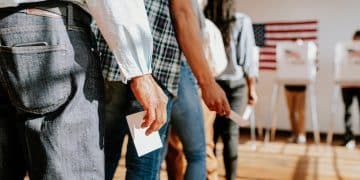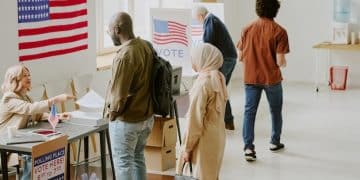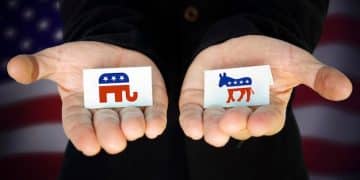Analyzing the Impact of New Voting Laws on Minority Access in 2026 Elections
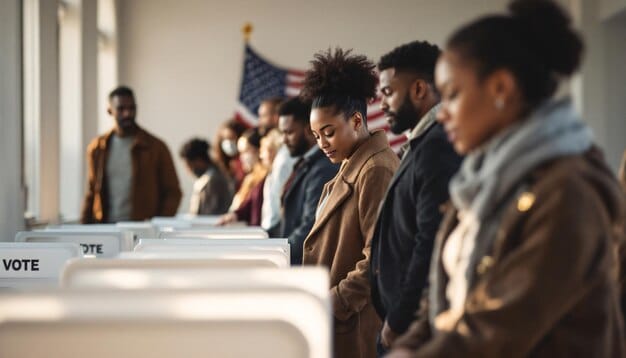
Analyzing the impact of the new voting laws on minority voter access in the 2026 elections involves examining potential barriers such as stricter ID requirements, reduced early voting, and limited polling locations, and understanding their implications for democratic participation.
The upcoming 2026 elections are already under scrutiny as new voting laws take effect across the United States. Analyzing the impact of the new voting laws on minority voter access in the 2026 elections is crucial to understanding whether these changes will empower or disenfranchise voters.
Understanding the Evolving Landscape of Voting Laws
The United States has a complex and ever-changing landscape of voting laws. Recent years have seen a surge in new legislation affecting how, when, and where people can vote, prompting concerns about their potential impact on different demographic groups.
New voting laws aim to improve election integrity and reduce fraud, while critics argue that they disproportionately affect minority voters, creating unnecessary barriers to participation.
Key Provisions of New Voting Laws
Many states have implemented new voting laws with varying provisions. Here are some key elements commonly found in these laws:
- Stricter ID Requirements: Laws requiring specific forms of photo identification to vote.
- Reduced Early Voting: Decreasing the number of days or hours available for early voting.
- Limitations on Mail-In Voting: Restrictions on who can request and submit absentee ballots.
- Polling Location Changes: Closing or relocating polling places, often in areas with large minority populations.
These provisions of the new voting laws have sparked intensive discourse, with proponents arguing for improved election security and opponents highlighting the potential for voter suppression.
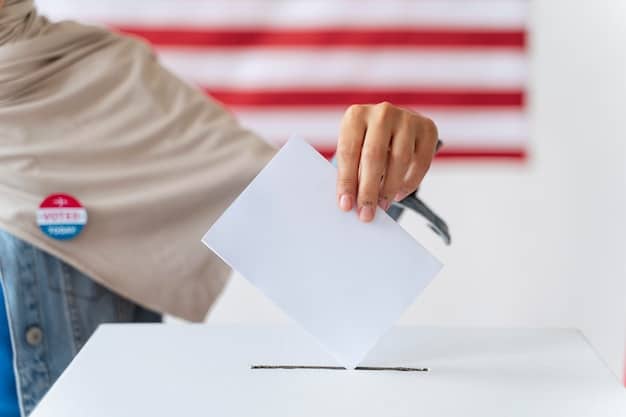
Impact on African American Voter Access
African American voters have historically faced significant obstacles to exercising their right to vote. The new voting laws present fresh concerns about their potential to exacerbate existing disparities.
Understanding how these new regulations might affect this demographic requires a closer look at geographical distribution, historical voting patterns, and socio-economic factors.
Geographical Disparities
The impact of new voting laws is not uniform across the country. States with a history of racial discrimination in voting, particularly in the South, are closely scrutinized.
These states often exhibit geographical disparities, where minority communities have fewer polling locations, limited access to transportation, and greater challenges in meeting strict ID requirements.
- Limited Polling Locations: Fewer polling places in predominantly African American neighborhoods.
- Transportation Barriers: Lack of public transportation options for reaching polling locations.
- ID Acquisition: Difficulties in obtaining required photo IDs due to cost or documentation issues.
The geographical disparities, compounded by the new voting laws, pose considerable challenges to African American individuals looking to exercise their right to vote.
The Hispanic Voter Experience and Barriers
The Hispanic community is one of the fastest-growing demographic groups in the United States, making their participation in elections increasingly important.
However, language barriers, citizenship issues, and socio-economic factors can significantly impact their access to the ballot box. New voting laws add another layer of complexity.
Challenges Faced by Hispanic Voters
Hispanic voters often face logistical and informational barriers that affect their ability to vote. It is important to understand these obstacles in order to facilitate greater inclusivity and broader democratic participation.
These obstacles include lack of Spanish-language voting materials in some locales, concerns about immigration status affecting voter eligibility, and general unfamiliarity with the voting process.
- Language Barriers: Limited English proficiency impacting understanding of voting procedures and materials.
- Citizenship Concerns: Fear or confusion regarding voter eligibility based on immigration status.
- Socio-Economic Factors: Limited access to resources necessary to navigate the voting process.
Addressing these challenges will be essential to encourage and support the Hispanic population’s active participation in the coming elections.
Native American Voting Rights Under Scrutiny
Native American communities face unique challenges regarding voter access, often stemming from their geographic isolation, lack of traditional mailing addresses, and historical disenfranchisement.
Recent changes in voting laws have the potential to further marginalize these communities and hinder their ability to participate in the democratic process, according to local leaders.
Unique Obstacles Facing Native American Voters
Beyond the barriers faced by other minority groups, Native Americans also encounter distinct challenges that affect their voter access. These stem from long-standing issues like rural isolation, historical injustices, and systemic discrimination.
One of the biggest impediments is the lack of standardized street addresses on reservations, making it difficult to register and receive mail-in ballots. Another concern is the distance to polling places, given that most Native American voters live in far-flung regions.
- Lack of Standardized Addresses: Difficulty in registering due to non-traditional addresses on reservations.
- Remote Polling Locations: Long distances required to travel to polling places.
- Language and Cultural Barriers: Limited availability of voting materials in native languages.
These specific barriers call for targeted solutions that acknowledge and address the unique cultural and logistical circumstances of Native American communities.
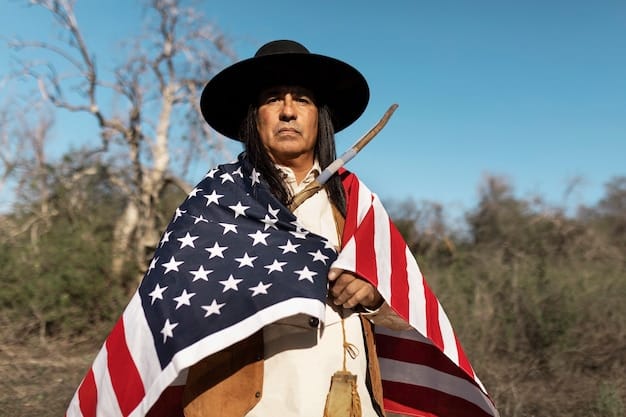
Legal Challenges and Advocacy Efforts
The new voting laws have sparked numerous legal challenges and advocacy efforts aimed at protecting voter access and preventing disenfranchisement of minorities. These lawsuits and advocacy campaigns seek to ensure equal access to the ballot box for all eligible voters.
Many organizations are actively involved in challenging these laws in court, arguing that they violate the Constitution and federal voting rights laws. Others are focused on voter education and mobilization to counteract any potential suppression effects.
Key Legal Battles
Here we will review some of the key ongoing legal battles and advocacy efforts and their potential impact on the 2026 elections and beyond.
These include:
- Lawsuits Against Voter ID Laws: Challenges to laws requiring strict photo identification, arguing they disproportionately affect minority voters who may lack necessary documentation.
- Challenges to Early Voting Restrictions: Legal actions against reduced early voting periods, claiming it limits voting opportunities for working-class and minority voters.
- Advocacy for Expanded Voting Access: Campaigns pushing for automatic voter registration, same-day registration, and other measures to make voting more accessible
The outcomes of these legal and advocacy efforts will have a tremendous role in shaping the accessibility of the ballot box for minority voters in the 2026 elections.
Potential Outcomes and the Future of Voter Access
The 2026 elections will serve as a pivotal test of whether the new voting laws increase election integrity or suppress minority voter participation. Election officials, advocacy groups, and civil rights organizations are closely monitoring the situation to gauge the effects of these new voting laws.
If minority voter turnout decreases significantly in the 2026 elections, it could lead to calls for further reforms, greater scrutiny of voting laws, and increased legal challenges to those laws. Conversely, a high turnout rate among minorities may diminish concerns about voter suppression and validate the reforms from a certain perspective.
Scenarios for the Future
There are several scenarios that could play out in the coming years, depending on the impact of the new voting laws and the response from various stakeholders.
These include:
- Increased Voter Mobilization: Advocacy groups and political parties may intensify efforts to register and mobilize minority voters, mitigating the effects of restrictive voting laws.
- Federal Intervention: Congress could pass legislation to establish national standards for voting access, overriding state laws that are seen as discriminatory.
- Changes in Public Opinion: Public sentiment toward voting laws may shift as more data becomes available on their impact, leading to further legislative reforms or ballot initiatives.
Ultimately, the future of voter access in the United States will depend on ongoing debates, legal battles, and the engagement of concerned citizens in the democratic process.
| Key Point | Brief Description |
|---|---|
| 🗳️ Stricter ID Laws | Requiring specific photo IDs can disproportionately affect minority voters. |
| ⏰ Reduced Early Voting | Decreasing early voting days can limit accessibility for some voters. |
| 📍 Polling Location Changes | Closing or moving polling places can create transportation challenges, especially in minority communities. |
| 🗣️ Advocacy Efforts | Legal challenges and voter education are vital in protecting voter access. |
Frequently Asked Questions
▼
Voter ID laws require voters to show identification at the polls. These laws vary by state, with some requiring photo IDs and others accepting non-photo IDs. Critics argue strict laws disproportionately impact minority voters.
▼
Reducing early voting days or hours can limit opportunities for minority voters who may have inflexible work schedules or limited access to transportation. This can result in fewer voters at the polls.
▼
Polling locations may be changed due to budget cuts, accessibility issues, or redistricting. Critics argue that closing or moving polling places in minority neighborhoods can suppress votes and discourage participation.
▼
Protecting voter access involves supporting voter education, registration drives, and legal challenges to restrictive laws. It also includes advocating for measures to simplify and modernize the voting process for all citizens.
▼
Language barriers can make it difficult for Hispanic voters who have limited English proficiency to fully understand election procedures, candidate information, and voting materials. This can lead to lower participation rates in those communities.
Conclusion
Analyzing the impact of the new voting laws on minority voter access in the 2026 elections reveals a host of complex challenges requiring vigilant oversight and proactive measures to ensure equal and fair access to the ballot box for all citizens. The ongoing debates and legal challenges underscore the importance of safeguarding democratic principles and promoting inclusivity in the electoral process.
